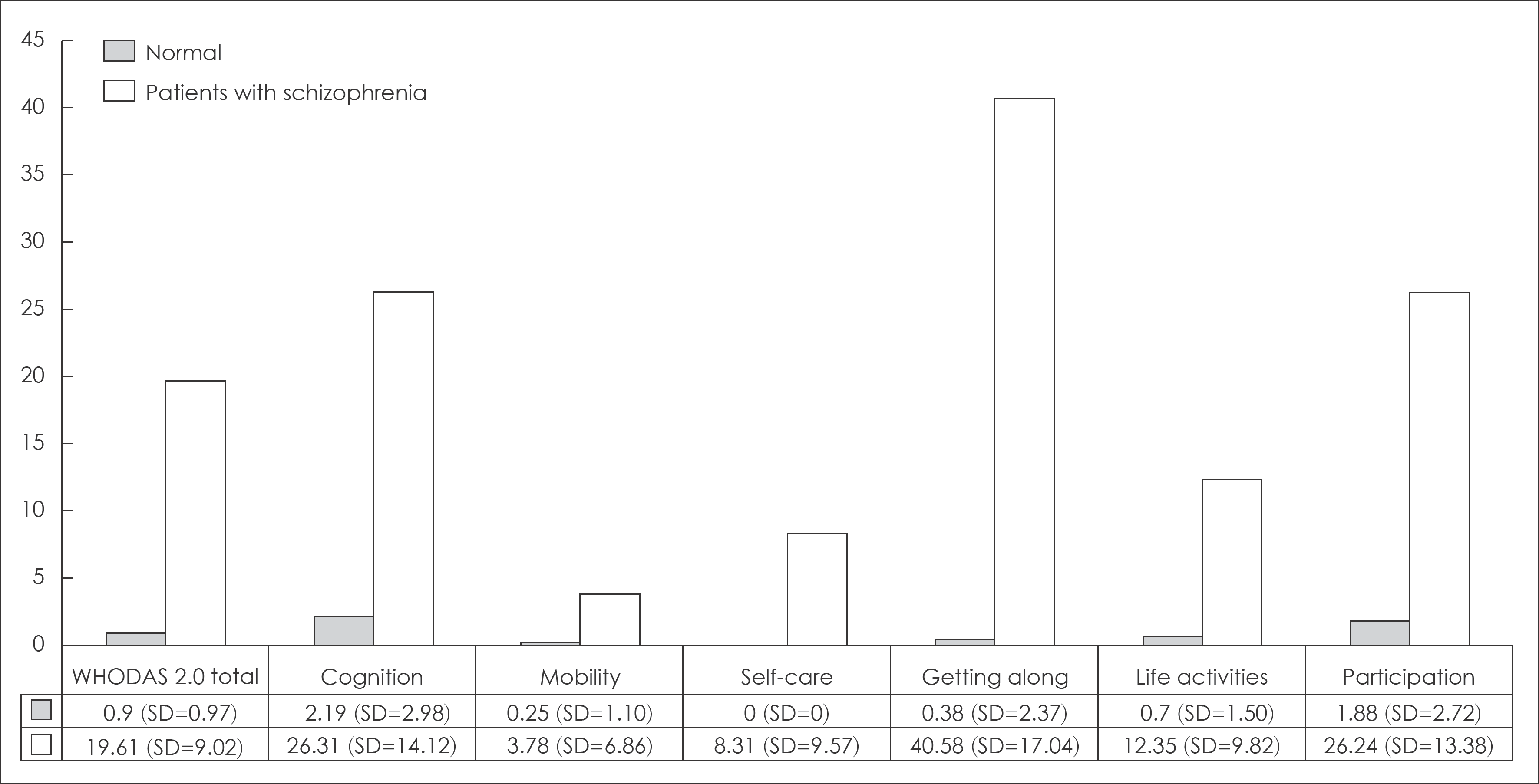Abstract
Objectives
This study examined the functional disabilities of patients with chronic schizophrenia using WHO Disability Assessment Schedule 2.0 (WHODAS 2.0) and its related factors.
Methods
The subjects consisted of 86 patients with schizophrenia with more than 10 years’ duration of illness and 40 healthy volunteers. The functional disabilities and psychopathology were evaluated using the WHODAS 2.0 and 18-items Brief Psychiatric Rating Scale (BPRS-18), respectively. This study analyzed the six sub-domains (‘cognition’, ‘mobility’, ‘self-care’, ‘getting along’, ‘life activities’, and ‘participation’) of WHODAS 2.0 and the four sub-scales (‘positive symptoms’, ‘negative symptoms’, ‘affect’, and ‘resistance’) of BPRS-18.
Results
Patients with chronic schizophrenia experienced severe functional disabilities across all six sub-domains of WHODAS 2.0 compared to healthy people. Hierarchical regression showed that ‘negative symptoms’ explained the disabilities in the WHODAS 2.0 sub-domains of ‘cognition’ (p<0.05), ‘self-care’ (p<0.05), ‘getting along’ (p<0.01), and ‘life activities’ (p<0.05). ‘Positive symptoms’ and ‘affect’ explained the disabilities in ‘cognition’ (p<0.01 and p<0.05, respectively) and ‘participation’ (p<0.05 and p<0.01, respectively). ‘Resistance’ was found to be a predictor of ‘getting along’ disabilities (p<0.01).
Conclusion
Negative symptoms mainly accounted for the multiple domains of functional disabilities in the WHODAS 2.0 but residual positive and affective symptoms could also deteriorate the cognition and social participation of patients with chronic schizophrenia. J Korean Neuropsychiatr Assoc 2019;58(1):47-54
Go to : 
REFERENCES
1.Carpenter WT Jr., Strauss JS. The prediction of outcome in schizophrenia. IV: eleven-year follow-up of the Washington IPSS cohort. J Nerv Ment Dis. 1991. 179:517–525.
2.An der Heiden W., Häfner H. Investigating the long-term course of schizophrenia by sequence analysis. Psychiatry Res. 2015. 228:551–559.

3.Hong JP., Kim CY. Course and outcome of schizophrenia. Korean J Psychopathol. 1999. 8:140–150.
4.Cancro R., Meyerson AT. Prevention of disability and stigma related to schizophrenia: a review. Schizophrenia. 1999. 2:243–310.

5.Knapp M., Simon J., Percudani M., Almond S. Economics of schizophrenia: a review. Maj Mario, Sartorius Norman, editors. editors.WPA Series in Evidence-Based Psychiatry: Schizophrenia. 2nd ed.Chichester: Wiley;2002. p. 413–460.

6.Norman RM., Malla AK., McLean T., Voruganti LP., Cortese L., McIntosh E, et al. The relationship of symptoms and level of functioning in schizophrenia to general wellbeing and the Quality of Life Scale. Acta Psychiatr Scand. 2000. 102:303–309.

7.Ritsner MS., Awad AG. Quality of life impairment in schizophrenia, mood and anxiety disorders. Dordrecht: Springer;2007. p. 159–226.
8.Veltro F., Magliano L., Lobrace S., Morosini P., Maj M. Burden on key relatives of patients with schizophrenia vs neurotic disorders: a pilot study. Soc Psychiatry Psychiatr Epidemiol. 1994. 29:66–70.
9.Breier A., Schreiber JL., Dyer J., Pickar D. National Institute of Mental Health longitudinal study of chronic schizophrenia: prognosis and predictors of outcome. Arch Gen Psychiatry. 1991. 48:239–246.
10.Bechi M., Bosia M., Spangaro M., Buonocore M., Cavedoni S., Agosto-ni G, et al. Exploring functioning in schizophrenia: predictors of functional capacity and real-world behaviour. Psychiatry Res. 2017. 251:118–124.

11.Bowie CR., Depp C., McGrath JA., Wolyniec P., Mausbach BT., Thorn-quist MH, et al. Prediction of real-world functional disability in chronic mental disorders: a comparison of schizophrenia and bipolar disorder. Am J Psychiatry. 2010. 167:1116–1124.

12.Chi SH., Jeong HG., Lee MS., Kim SH. Factors predicting personal and social performance in schizophrenia patients. Korean J Schizophr Res. 2016. 19:47–59.

13.Shamsi S., Lau A., Lencz T., Burdick KE., DeRosse P., Brenner R, et al. Cognitive and symptomatic predictors of functional disability in schizophrenia. Schizophr Res. 2011. 126:257–264.

14.Siegel SJ., Irani F., Brensinger CM., Kohler CG., Bilker WB., Ragland JD, et al. Prognostic variables at intake and long-term level of function in schizophrenia. Am J Psychiatry. 2006. 163:433–441.

15.American Psychiatric Association. Diagnostic and statistical manual of mental disorders (DSM-5®). 5th ed.Washington DC: American Psychiatric Association;2013.
16.Jones SH., Thornicroft G., Coffey M., Dunn G. A brief mental health outcome scale-reliability and validity of the global assessment of functioning (GAF). Br J Psychiatry. 1995. 166:654–659.
17.Leon AC., Olfson M., Portera L., Farber L., Sheehan DV. Assessing psychiatric impairment in primary care with the Sheehan Disability Scale. Int J Psychiatry Med. 1997. 27:93–105.

18.Gold LH. DSM-5 and the assessment of functioning: the World Health Organization Disability Assessment Schedule 2.0 (WHODAS 2.0). J Am Acad Psychiatry Law. 2014. 42:173–181.
19.Sheehan DV., Lecrubier Y., Sheehan KH., Amorim P., Janavs J., Weiller E, et al. The Mini-International Neuropsychiatric Interview (M.I.N.I.): the development and validation of a structured diagnostic psychiatric interview for DSM-IV and ICD-10. J Clin Psychiatry. 1998. 59(Suppl 20):22–33.
20.Yoo SW., Kim YS., Noh JS., Oh KS., Kim CH., NamKoong K, et al. Validity of Korean version of the mini-international neuropsychiatric interview. Anxiety and Mood. 2006. 2:50–55.
21.Üstün TB., Chatterji S., Kostanjsek N., Rehm J., Kennedy C., Epping-Jordan J, et al. Developing the World Health Organization Disability Assessment Schedule 2.0. Bull World Health Organ. 2010. 88:815–823.

22.Üstün TB, Kostanjsek N, Chatterji S, Rehm J (Eds.). Measuring health and disability: Manual for WHO disability assessment schedule (WHODAS 2.0). Geneva: World Health Organization;2010.
23.Yoon JS., Kim JM., Shin IS., Yang SJ., Zheng TJ., Lee HY. Development of Korean version of World Health Organization Disability Assessment Schedule II (WHODAS II-K) in community dwelling elders. J Korean Neuropsychiatr Assoc. 2004. 43:86–92.
24.Overall JE., Gorham DR. The Brief Psychiatric Rating Scale (BPRS): recent developments in ascertainment and scaling. Psychopharmacol Bull. 1988. 24:97–98.
25.Shafer A. Meta-analysis of the brief psychiatric rating scale factor structure. Psychol Assess. 2005. 17:324–335.

26.Kim MK., Lee BK., Jeon YW. Reliability of Korean brief psychiatric rating scale (BPRS): comparison of interrater reliability between the two rating methods and correlation of BPRS and SCL-90 self-report test. Korean J Clin Psychol. 2003. 22:685–698.
Go to : 
 | Fig. 1.Comparisons of WHODAS 2.0 mean scores between normal and patients of schizophrenia. WHODAS 2.0 : World Health Organization Disability Assessment Schedule 2.0, SD : Standard deviation. |
Table 1.
Comparison of descriptive statistics between normal and patients with schizophrenia
Table 2.
Zero-order correlations among patients with schizophrenia
Table 3.
Predictors of disabilities




 PDF
PDF ePub
ePub Citation
Citation Print
Print


 XML Download
XML Download